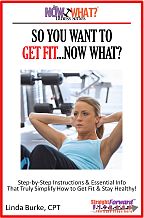Buy "The Now What? eBooks" Here! Or go to Smashwords for misc. formats.
The Now What Fitness Series lays out the foundation of fitness in a concise and simplified manner, making for a collection of books that help the reader truly comprehend how to improve one's health and well-being from A to Z. I've broken fitness down into comprehensive concepts, giving anybody who truly wants to change their health and their lives in profound ways, the step-by-step tools and knowledge to do so.
Compound Exercise Demonstrations
Following are some very basic compound exercise demonstrations, including start and finish pictures and instructions on how to perform them correctly. Remember: Compound exercises are double-joint exercises that work more than one muscle at a time, i.e., presses, pull-ups, pull-downs, rows, squats, lunges, leg presses, etc. The exercise demonstrations shown below are:
These are just a few of the literally hundreds of compound exercises and variations thereof. The ones shown below are not meant to be performed together as a routine, but are merely examples of compound exercises. With these compound exercise demonstrations and instructions, you will better understand the difference between compound and isolation exercises and why you need to perform both kinds.
It is my hope that with this better understanding, you can plan a strength training program utilizing these basic strength training exercises more appropriately, and, thus, more effectively and safely.
You should read the guidelines of strength training and check with your doctor before beginning your resistance program.
CLARIFYING COMPOUND MOVEMENTS
Notice how there are at least 2 joint movements involved in the execution of
each exercise.
Also note that each upper body exercise, though meant to target primarily
bigger muscles such as chest, back, or shoulders, must utilize the arms in
order to be performed. Therefore, for the most part, the upper body compound
exercises utilize all the upper body muscle groups; likewise, the lower body
exercises utilize all the lower body muscle groups.
It should be duly noted, however, that particular compound exercises do put
more emphasis on specific muscle groups, i.e., the chest press on the chest and
the shoulder press on the shoulders.
Now, do you see why these are called COMPOUND exercises?
COMPOUND EXERCISE DEMONSTRATIONS
Dumbbell Chest Press - These may be done flat, incline, or decline. There are also
many brands of chest press exercise machines, i.e., Nautilus, Hammer Strength,
etc. Primary muscle group worked-Chest. Click here to see video demo.
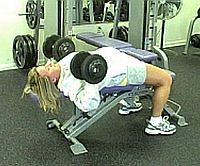
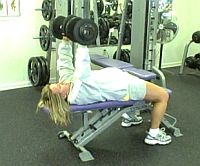
Starting Position: Place an adjustable bench in the flat position. Hold the dumbbells just above shoulder height, keeping the weight distributed in a straight line directly above the elbows as shown in picture. Movement: Exhale as you slowly straighten the arms to a soft lock position (almost straight) at the top, pressing the weight up to touch at the top. Reverse this arching motion on the way back down and repeat for desired amount of reps. Tips: Exhale as you press the weight up and keep the wrists as straight as possible. Try to use the chest muscles instead of the arms. This is tricky, so focus and remember practice makes perfect. Optional: Bringing the feet up on the bench helps protect your lower back. You may opt to keep your feet flat on the floor.
DB Shoulder Press - These
may be done with dumbbells, barbells, the Smith machine, or a number of other
brands of shoulder press machine, i.e., Nautilus, Hammer Strength, etc. Primary muscle group
worked-Shoulders. Click here to see video demo.
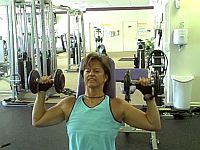
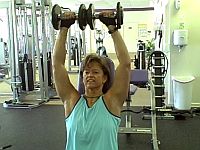
Starting
Position: Place a seated
bench in the upright position. Allow the bench to support your head and neck
with your head resting against the bench and feet flat on the floor. Hold the
dumbbells in each hand at just above shoulder height. Be sure weight is
distributed in a straight line directly above the elbows. Movement: With
palms facing away from you press the weight straight up until arms are extended
overhead. Lower and repeat for the desired number of reps.
Pull-ups - These are very difficult and require an enormous amount of upper body strength. They can be done in a modified style to build up strength in order to become strong enough to do free style. I am demonstrating the modified style, the Smith Pull-up. Primary muscle group worked-Back. Click here to see video demo.
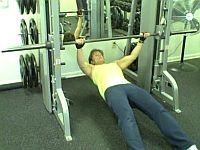
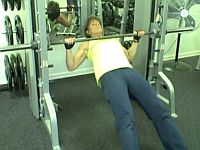
Starting
Position: Set the bar on
the Smith Machine at desired height. (The lower the bar, the greater the
difficulty.) Take a wide, overhand grip keeping elbows in soft lock at bottom
of move. Lie beneath the bar with the bar just above the chest. Keep body
straight from head to toe with a soft lock in knees throughout. Movement: Exhale
as you slowly bend arms and raise body towards the bar nearly touching chest to
bar. Inhale as you slowly return to start position for desired number of reps. Tip: Move the bar up to decrease difficulty.
Lat Pull-downs - These
should be done pulling only to the front since the back pull-down has been
proven to be dangerous for your shoulders and neck. Primary muscle group
worked-Upper/Mid Back. Click here to see video demo.
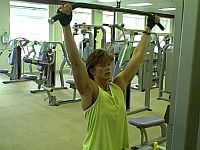
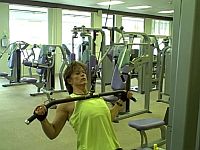
Starting
Position: Grasp the bar
just past the bend on each side with thumbs up and over the bar. Allow upper
body to feel a good stretch and keep a slight natural arch in the lower back
throughout the move. Movement: Slightly lean back as you pull
the bar down to the upper chest. Pause and slowly return to the start position
while bringing body back up completely straight for the stretch in the lats
(upper back). Repeat for the desired number of reps. Tips: Envision
bringing the chest up to meet the bar and keep chin slightly tilted up
throughout.
Bent-over DB Rows - These
can be done with dumbbells, Smith machine, barbells, various row machines, cable row, and
apparatuses. I am demonstrating the Bent-over DB row. Primary muscle group
worked-Back. Click here to see video demo of bentover row.
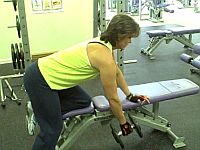
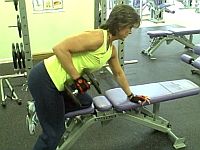
Starting
Position: Place
one hand and the same-side knee on an exercise bench, the foot of the opposite
leg on the floor, and the hand on that side of the body holding a dumbbell in
your hand, hanging at arms length below your shoulder at a slight angle as
shown. Movement: Exhale as you pull the dumbbell upward in a
slight angle until it touches your lower ribs/outer waist as if starting a
lawnmower or sawing. Inhale as you lower the dumbbell slowly to the starting
position. Repeat for desired amount of reps. Switch sides and repeat. Tips: Be
sure to keep arm/elbow in tight and as close to the body as possible as you
raise the dumbbell. Think good posture, keeping a natural slight arch in your
lower back and flat upper back throughout.
Swiss Ball Wall Squats - There
are many variations of the squat. I prefer these because of the lumbar spine
(lower back) support that the Swiss ball provides. These work the entire lower
body--Quads (front of upper leg), Hams (back of upper leg), and Glutes or butt.
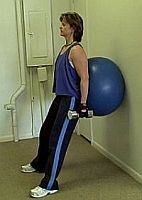
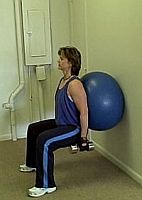
Starting
Position: Position an
exercise ball between your middle/lower back and a wall. Stand with your feet
shoulder width apart, toes pointed slightly outward. Distribute your body
weight equally between both feet and lean back against the ball. Movement: Inhale,
keeping your heels in contact with the floor at all times, slowly lower into a
squat position while rolling the ball up your back. Exhale as you slowly
straighten your legs, keeping your head and chest up, returning to the starting
position. Repeat as required. Tips: Squat down as low as if
you were going to touch your butt to a chair and then return to the upright
position. You may hold a dumbbell (as shown) for added resistance or increased
level of difficulty.
Anchored Reverse Lunges - There are several forms of the lunge. I am demonstrating an
anchored reverse lunge. Primary muscle group worked-Glutes, Hams, Quads. Click here to see video demo.
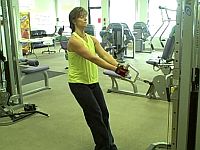
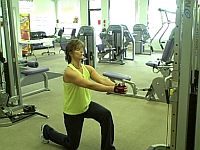
Starting
Position: Stand
with your feet hip width apart and a slight bend in your knees. Grip a stable
handle that can support your weight and slightly hang backwards, keeping your
body in a straight position as shown in the picture with both arms extended out
in front of you. Movement: Inhale as you take a large step
back and lower yourself down until your front knee has a 90-degree bend in it.
Exhale as you press yourself back up to the starting position. Repeat with
other leg, alternating sides for desired amount of reps.
Leg Press - This
is only one of many types of Leg press machines. Primary muscle group
worked-Glutes, Hams, Quads.
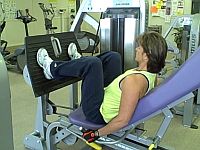
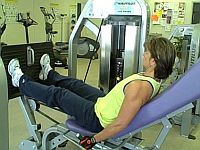
Starting
Position: Adjust
back rest as low as it will go (or to comfort) and adjust sled setting
underneath hips so that you can achieve a 90 degree angle with the knees
without the weight stack touching as shown in picture. Place feet in desired
position (close together, wide apart, etc.) with toes slightly pointed out. Movement: Exhale
as you slowly straighten legs until knees are in a soft lock (slightly bent)
position. Inhale and slowly return to start position for desired number of
reps.
So Many Compound Exercises...So Little Space
I have only scratched the surface of the myriad choices of exercises, be they isolation or compound.
It should also be noted that it is possible to perform all of the above or some version of them with resistance bands. With so many exercise choices, you should never be bored with your workout.
Click here to see some examples of Isolation Exercises.
Return from Compound Exercise Demonstrations to Strength Routines
Return from Compound Exercise Demonstrations to SF Home
